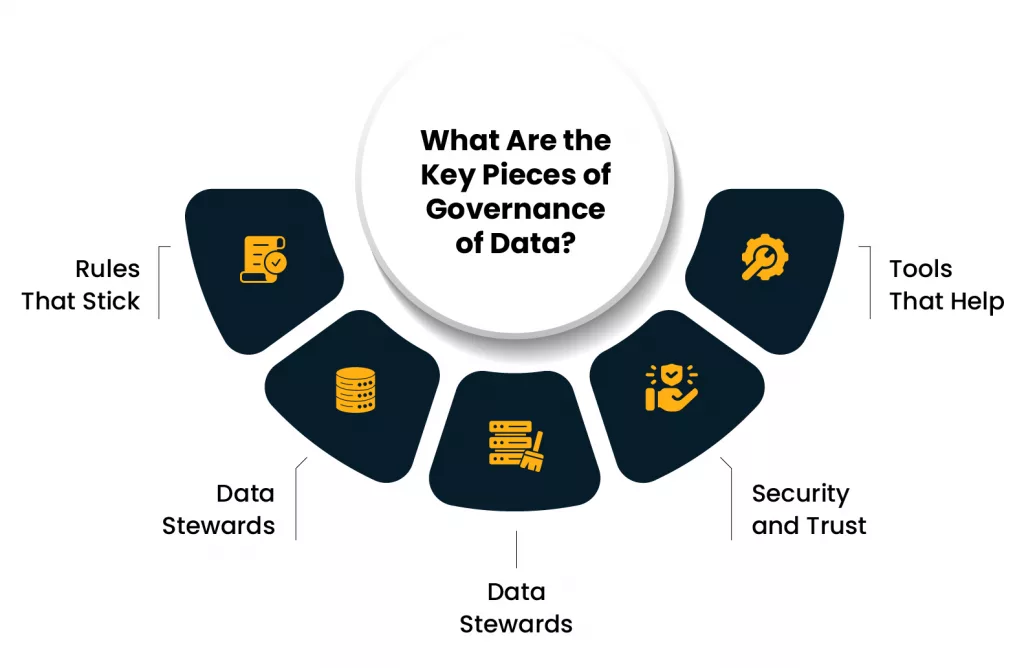Every enterprise today swims in data! Customer records, sales numbers, supply chain details. But raw data is only as good as how you manage it. If it’s messy, insecure, or hard to use, it’s more trouble than it’s worth. That’s where governance of data comes in.
So, what is data governance? It’s the system that keeps your data reliable, safe, and ready to support your business. This guide dives into what it means, why it matters, and how to make it work, written for business leaders, IT crews, and data teams who want to get it right.
What is Data Governance?
At its heart, governance of data is about setting up clear rules and processes to manage your data. It’s not a quick tech fix or a one-and-done project, it’s an ongoing way to treat data like a core part of your business.
It decides who can touch data, how they use it, and what standards it needs to meet. Unlike data management, which handles the tech side like storing or analyzing data, governance of data is about strategy and accountability.
For big organizations, governing data is a juggling act. You’ve got to keep regulators happy, protect customer trust, and still use data to grow. It’s less about fancy software and more about making sure every piece of data serves a purpose.
Why It’s Worth Your Time?
Data can make or break your business. Strict laws like GDPR, CCPA, or HIPAA mean you can’t afford slip-ups, and customers won’t stick around if they think you’re careless with their info.
Weak governance can lead to fines, breaches, or decisions based on faulty data. But when you get it right, you’re building a foundation for better choices, decisions, trust, and efficiency.
Here’s what this brings to the table-
- Stay legal– Meet regulations to dodge hefty fines.
- Keep data solid– Make sure your data is accurate for better decisions.
- Lock it down– Protect sensitive info from leaks or misuse.
- Work together– Help teams share data without confusion.
- Save money– Cut waste by streamlining how data is handled.
What Are the Key Pieces of Governance of Data?

A strong governance setup has a few core parts that work together to keep things tight and organized.
1. Rules That Stick
Policies are the guardrails for data. They cover who can access what, how long you keep data, or whether it’s public or private.
Standards make sure everyone’s on the same page agreeing to write dates as YYYY-MM-DD or using consistent names for files.
For example, a policy might say customer data gets anonymized before it’s analyzed, while a standard ensures all sales reports use the same metrics.
2. Data Stewards
Stewards are the people who “own” specific chunks of data, like finance or HR records. They make sure data follows the rules, fix problems, and connect the business side with IT. Having clear stewards means no one’s left guessing who’s responsible.
3. Clean Data
Good data is accurate, complete, and fresh. Data sets up ways to check quality, like regular audits or tools to spot duplicates. Messy data can tank your plans! Imagine sending promos to the wrong customers because your records are outdated.
4. Security and Trust
Protecting data is non-negotiable. Governance of data lays out access controls, encryption, and tracking to see who’s using what. It also keeps you compliant with privacy laws, which keeps customers happy and regulators at bay.
5. Tools That Help
While governance of data isn’t just about tech, tools make it easier. Data catalogs help people find what they need fast. Security systems enforce your rules. These cut down on manual work and keep things running smoothly.
What are some Data Governance Frameworks?
A data governance framework is your roadmap for putting all this into action. It spells out roles, steps, and goals to keep everyone aligned. No two businesses are the same, but most frameworks share some common ground.
Here are a few data governance frameworks you might run into:
- DAMA-DMBOK– A go-to guide for governance, quality, and more, used in all sorts of industries.
- COBIT– Ties governance of data to IT and risk management, perfect for compliance-heavy businesses.
- ISO 38505– Focuses on accountability and linking data to your big-picture goals.
You’ll need to tailor any framework to your needs. A healthcare provider might zero in on HIPAA rules, while a retailer might care more about customer data for targeted ads. Choose one that fits your industry and tweak it to work for you.
Ask yourself-
- Can it grow? Will it keep up as your data gets bigger?
- Does it match? Does it cover your industry’s regulations?
- Is it realistic? Can your team actually pull it off?
How to Build Your Data Governance Program?
Kicking off a governance data program doesn’t have to be a headache. Here’s a simple plan to get started.
Step 1- Nail Down Your Goals
Figure out what you’re after. Want to avoid fines? Clean up bad data? Speed up analytics? Clear goals keep you on track and help sell the idea to your bosses.
Step 2- Take a Hard Look
Audit your data to see what you’re dealing with. Spot problems like inconsistent records or unclear owners. This shows you where to focus first.
Step 3- Pick Your Team
Name stewards for key data areas and pull together a governance group with folks from business, IT, and legal. Clear roles cut down on chaos.
Step 4- Set the Rules
Write straightforward policies for access, quality, and security. Map out how to handle requests or fix issues. Keep it simple so people actually use them.
Step 5- Grab Some Tools
Pick tools like data catalogs or access controls that play nice with your systems. Make sure they’re user-friendly to avoid headaches.
Step 6- Stay on It
Data isn’t a set-it-and-forget-it deal. Track things like data accuracy or compliance rates. Check in regularly to tweak your setup as laws or needs change.
Why Data Governance Consulting Services Are a Lifesaver?
Building data from scratch can feel like climbing a mountain. That’s where data governance consulting services come in. These pros bring know-how and hands-on help to get you moving.
They can-
- Size things up– Spot gaps and suggest smart fixes.
- Make it yours– Shape frameworks like DAMA-DMBOK to fit your business.
- Train your crew– Teach your team to keep things running.
- Set up tech– Get tools installed and work fast.
When picking a consultant, go for someone who knows your industry and focuses on real results. They should team up with your staff so you’re ready to take over when they’re done.
Dodging Common Pitfalls
Governance of data can hit some bumps. Here’s how to steer clear-
- Pushback– Some folks might grumble about extra work. Show them how it makes their lives easier, like finding clean data faster, and get their input.
- Silos– Business and IT don’t always click. A mixed governance team keeps everyone in sync.
- Tight budgets– If resources are slim, start with must-haves like compliance and grow from there.
- Shifting rules– Laws change. Regular check-ins and flexible policies keep you covered.
What’s Coming for Data Governance?
With AI and cloud tech on the rise, AI-powered data governance is evolving. AI needs top-notch data to avoid garbage results, and cloud systems need governance that works across platforms.
Keep an eye on:
- Smart tools– Systems that catch data issues on the fly.
- Wider access– Rules that let more staff use data safely.
- Eco-friendly data– Plans that factor in the energy cost of storage.
Get Going with Data Governance
Data is a big commitment, but it’s a game-changer. Enterprises that nail it make sharper calls, stay on the right side of the law, and earn trust.
Start by checking your data, setting goals, and building a plan that scales. If you need a hand, data governance consulting services can jumpstart your efforts.
With data governance you’re making a powerhouse for your business.











